Its Meaning and Measurement
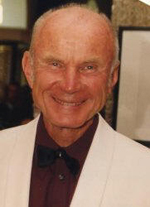
By Dr. med. Univ. Ivan Engler
1. The Vegetative Nervous System (VNS) or the Autonomic Nervous System (ANS)
The VNS [15] is a connected control circuit mainly independent of the will which you can divide as follows:
- Sympathetic Nervous System or sympathicus (S-)
- Parasympathetic, also Vagotonic Nervous System or vagus (V-)
The VNS consists of nerve cells embedded in the matrix of the Extracellular Regulative Ground System (= ERGS, [see in 3]), which form ganglions and ganglion strands, continue into the nerves and fibers, however not into the relevant organ cells but rather end in the ERGS.
The following are biocybernetically controlled by the VNS:
- The vital functions (consciousness, respiration, heart-circulation)
- The functions of all the organs as well as the systems
- The internal milieu, the so called “homeostasis” (water, oxygen, ions, temperature, acid-base, sugar, etc.) is held in balance
- The sequence of the stress reaction/H. Selye (see in 1.3, [14])
- The circadian rhythms (see in 1.4)
- The VNS is involved unnoticed in health, balanced character, concentration, psychic and physical behavior as well as performance and life expectancy.
The involvement of the VNS there is also measurable by e.g. Biotonometry (see in 6). To internal or external stimuli (= biophysical signals or stressors) the VNS answers in the form of a Vegetative Regulative Answer (VRA). The existing vegetative regulation situation (VRL) as an expression of the relation of the S- to the V- activity is changed:
- By a stressor, in each case depending on the vegetative type of the person (VT), it changes quickly and typically, particularly the heart frequency variability (HFV).
- As an expression of the V- part; and the blood pressure (BP) as an expression of the S- part.
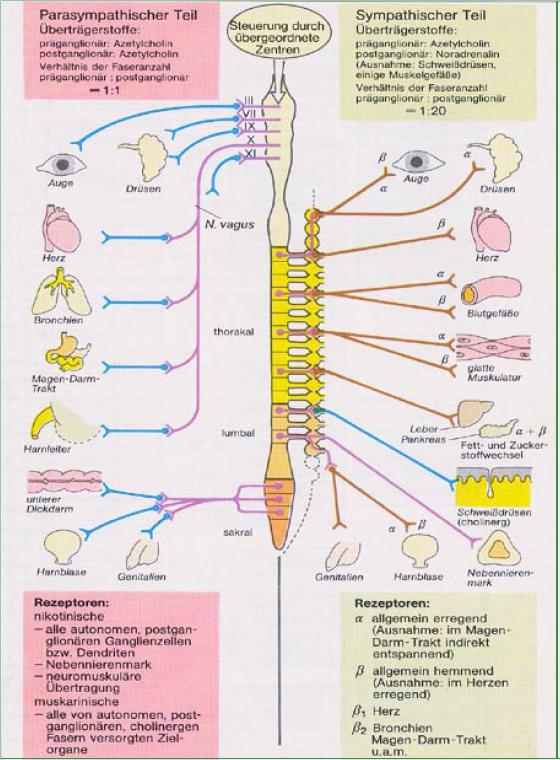
Figure 1. Vegetative Nervous System – Overview (from Literature [12, Page 51]).
For translation of terms see References below.
1.1 G. Hacker et al. from the University of Salzburg have observed significant changes in the HFV of test persons even with the burden of “controversial” geopathic zones (GZ) [5]. GZ burden the VNS as a chronic stressor (vegetative complaints, see Table 3); over time they weaken even the immune system. With almost all of my (roughly 300) patients with a cancerous disease, their bed was placed for years on an energetically unfavorable place in a GZ [in 3].
1.2 Different relaxation methods are vegetatively effective, e.g. autogenous training, yoga, 5 Tibetan exercises, meditation, biofeedback, MBSR by the device “Resperate” or by the effect of the IO2Th/Engler [1-3]. For the most part a V- effect on the HFV is initiated beyond the body’s relaxation and the changed respiration (free deep divers can lower their heart frequency down to 10/min. and suspend their breath for approx. 10 minutes with no consequences. At the same time the S- effect on the BP is weakened.). Thus because it is a matter of a will-dependent influence of the vital functions of the VNS, I use the term Vegetative Nervous System (VNS) instead of Autonomous Nervous System (ANS).
1.3 Control of the vegetative functions is shaped hierarchically from the psychological-emotional influence of the Central Nervous System (CNS), particularly from the cortex (psychological-cognitive functions), and further into the Limbic System (LS) which is responsible for regulation of behavior (desire, motivation, emotion). The paramount center for the VNS is the hypothalamus, which vegetatively controls the neurotropic hormones of the hypophysis and the whole endocrine system: thyroid gland, parathyroid gland, pancreas, ovaries, testes, adrenal cortex, and adrenal medulla.
During a stress reaction (H. Seley [14]) in the S-phase, the alarm reaction is involved in the VNS controlled catecholamine hormones of the adrenal medulla: noradrenalin and adrenalin (heart-circulation system, blood pressure, pulse, oxygen supply, energy supply, efficiency, etc.). Further the steroidal hormones of the adrenal cortex (cortisol and corticosteroid) provide the energy for “fight or flight” through the carbohydrates, free fatty acids and proteins. The adaptation phase is controlled by V-; the acetylcholine has an effect as a V-mediator.
1.4 Nils Bohr, the Nobel Prize winner for physics, used the Chinese Yin and Yang Monad as his Ex Libris. It is helpfully used as the logo for the IO2Th/Engler (from [3]).
Ionized Oxygen Therapy
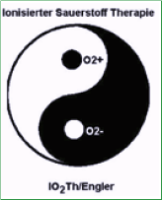
Figure 2: The Monad
The Monad symbolizes the following with the VNS regulation:
- The polarity of the S-effect is bright, male, negative charge, alkaline, inhale, systole, waking state, etc., and of the V-effect is dark, female, positive charge, acid, exhale, diastole, sleep, etc.
- S- also contains some of V- and vice versa: e.g., with stress (which is a domain of S-) the V- portion causes for the self-conscious test person the urge to pass water or for the stressed manager a peptic ulcer on the basis of an increased stomach secretion by V-.
- A “pure” sympathetic stimulation leads to a damping of V- and its functions and vice versa [13, Page 60].
- The mutual interconnection and dynamic balance between S- and V- can maintain the health or vice versa compensate a disbalance of the S- and V- forces (see Table 3 and Table 4)
- The sinusoid curve represents the course of the VRA. In Latin “sinus” means curve (= intended “s” line between the S- and V- forces of the Monad):
After a stimulus (stressor), normally only an S- phase occurs (noradrenalin and adrenalin thus enable the “fight or flight”) followed by a V- phase (acetylcholine with the adaptation phase). Only then can the VNS adapt in the direction of normotonia (N-, see Table 1 and 4, or in Figure 3) or return to the old VRL - All circadian biological rhythms (e.g. organ clock, ovulation cycle, seasonal rhythms, etc.) run sinusoid, even the day-night rhythm (see the sinusoid curve of the ACTH production in the day or in the night, in [13, Page 261]).
- Water (H2O) as an information carrier, or rather the life donors and the electromagnetic waves (EMW) which influence everything in principle, are symbolized by the sinusoid [3].
1.5 The vegetative ganglions along the vertebral column, and respectively in the head, can be assigned to the seven “energetic openings” in the body from old-Indian belief, to the so called chakras:
For example the 4th chakra corresponds to the heart, not only as a biomechanical pump, but also as the seat of the emotions (see limbic system under 1.3). The 6th forehead chakra could correspond to the higher vegetative center of the hypothalamus or to the hypophysis. Through self suggestion the chakras should vegetatively and energetically influence the hormone glands and the organs. For example, during a chakra meditation the tonus of V- with regard to the heart (bradycardia) is proven strengthened and the S- with regard to the vessels is weakened (hypotonia). With a meditation the Biotonometry registers the tendency toward Normotonia or Vagotonia.
2. The Three Basic Vegetative Regulation Situations (VRL), or the Vegetative Types (VT)
“Every attempt intending to explain life processes according to a static principle, either sympathicotonic or vagotonic, leads to results which do not justify the facts.” Prof. W. Birkmeier, in 1951.
After every stimulus or stressor, an autonomous, sinusoid-proceeding, vegetative, regulative answer (VRA) of the VNS occurs. Nevertheless the VNS is biocybernetically linked with the ERGS series connection (see in 3).
2.1 After the momentary tonus of S- or V- a corresponding VRA occurs, which shows an adaptive vegetative regulation situation (VRL) of the VNS. These VRL can continue:
- for a short time
- for a long time
- continuing more or less throughout the whole life, the so called vegetative type (VT)
The three VT are: Sympathicotonic (S-), Normotonic (N-) and Vagotonic (V-).
They react predominantly in a more typically vegetative manner to the different stressors, life-styles, and foods, but also with the origin and treatment of illnesses.
Young people, meat eaters, the stressed, etc. belong mostly to the S-. Vegetarians, seniors and the tired belong to the V-.
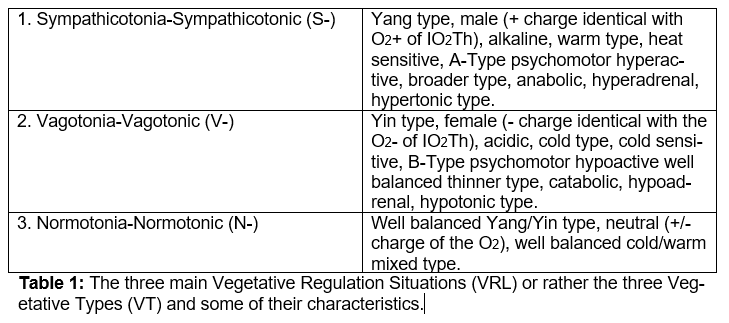
2.2 The regulation of the S- or V- tonus can be accomplished as follows:
- By experience, the so called “clinical picture” [6 and 13]
- By questioning the test person by means of a questionnaire (see Table 2)
- By differentiated blood count before and after a stimulus [6 and 13]
- By the orthostatic test, the so called Schellong Test (lying-standing)
- By measuring the heart frequency variability (HFV), which is associated with V- (ECG and statistical evaluation of the R-R intervals) or a continuous measurement of the blood pressure variability (BPV), which is associated with S- [8]
- Biotonometry/Kracmar-Rilling: by an electronic measurement of the skin- or the affiliated ERGS reaction after an electricity burdening: The R values in kΩ correspond to V- and the C values in µF correspond to S- [10-13]
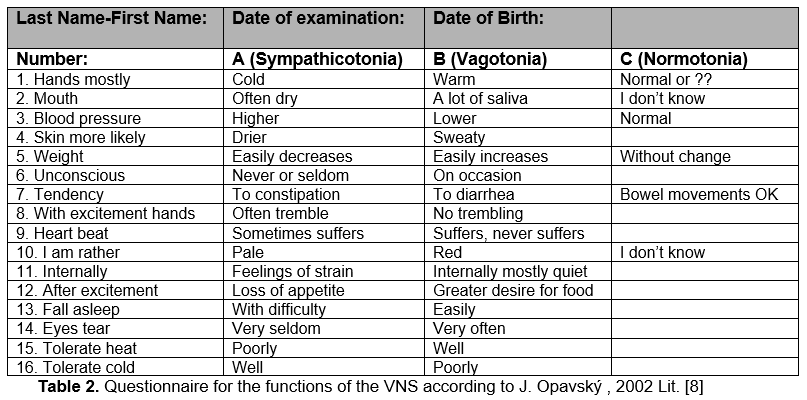
Through a combination of these three main types of the VRL a total of nine VRL possibilities arise (in Table 4). These VRL can only be registered by the Biotonometry.
The ending of the S- or V- fibers or the micro-capillaries (found near the just as rich vegetative nerve fibers), all these never flow directly into a cell. How do the stimuli come to the nerve cells and the VNS? How does it come to its VA, that a varied adaptive regulation can be evoked? Because the VNS is connected in series the same – a hardly considered system by orthodox medicine physiology and pathophysiology – the same as the extracellular regulative ground system (ERGS) [9].
3. Extracellular regulative ground system (ERGS / Pischinger – Heine)
Stressors, stimuli, medications, vaccinations, all varied therapeutic or preventive measures first work on the ERGS, then a VRA of the VNS occurs.
- ERGS [9] is also called the ground system, the matrix or the intercellular connective tissue. It is not only the supporting apparatus for the cells, but also a sensitive, even self organizing networked, watery system between the cells (transit area for O2, CO2, nutrients and waste materials).
- The ERGS consists of connective cells, collagen fibers, endings of micro-capillaries, micro-lymphatic vessels and fine S- and V- fibers or corpuscles. Above all however, it contains the rich extracellular “crystalline” water between the proteo-glycans network structure.
- The ERGS as an open energetic system holds +/- charges, pH (H●), electrical potential, as well as electromagnetic qualities, which can change the water structure information there. Through the vegetative nerve fibers a coupling to the VNS exists.
- Silicon (Si) comes in nature only in connection with oxygen (O2) as silicic acid (SiO2) or as silica and is the second most frequent element of the earth’s crust after O2. Si is important: for cell respiration, for construction and vigor of the connective tissue, for collagen synthesis in the arterial and venous walls, for the matrix and the mineralization (calcium insertion) of the bones, the cartilage of the joints, for the activity of the immune system, etc. In the human organism of 75 kg approximately 7 g Si are found, mostly in the crystalline, living intracellular or extracellular water of the ERGS. With a Si deficiency ERGS weakness, energy decline, immune weakness, skin problems like pruritis, premature aging, etc. can develop. Silicon conducts electrical current, is especially oscillation and resonance capable, and can change through the (EMF) energy between the states of paramagnetism and diamagnetism. The possible role of Si in information transfer needs scientific verification [3].
- The acupuncture points or the so called trigger points of the musculature are identified through cutaneous and subcutaneous measurements of the ground substance of the ERGS, which are under musculo-vascular influence. Through this a functional network of the ERGS is produced with the vegetative and somatic system. On this basis, the biologically superior subjects such as Acupuncture, Acupressure, Massage, Lymph drainage or such as the IO2Th/Engler are taken into consideration.
3.1 G. Litscher et al. of the University of Graz [7] proved with functional Transcranial Doppler Sonography (fTCD), functional Magnetic Resonance Imaging (fMRI) and Percutaneous Oxymetry of the brain (PCO), that through a Computer Controlled Laser Acupuncture treatment (CCL) the acupuncture points anatomically corresponding to cerebral areas are activated and that this therapy also shows an effect with different complaints.
3.2 “Blockage” of the ERGS and comparison of two device measurement methods with regard to the VNS:
The ERGS is simultaneously a radical catcher, a biological filter, and a “garbage can” with a limited capacity, where all endogenous and exogenous materials, poisons and radicals which are not diminished or eliminated are deposited. From the accumulation of stressors, from radicals (R●) not caught up by scavengers, or also from the aging process, a congestion (the so called “clogging up”) of the ERGS develops. The energy of the stressors (especially the R●) changes the watery structure of the ERGS (SolàGel) by which the material-, gas- and information-transfers to and from the cells becomes defective. For example, the oxygen supply of the cells suffers (measurable by O2- parameters) and the immune system (detectable by immune assay).
The “clogging up” of the ERGS [6, 9, 11] leads to a lengthening of the transit route, which is expressed in Biotonometry (e.g. with the “VNS Diagnosis 3000 / by Dr. Engler” measurement device) as a partial blockage of the VRL. The low C values in a long term curve hardly change after an electrical stimulus and the R values rise. An examination of the HFV or rather the continuous BP (e.g. with a “Finometer”*) cannot determine the clogging up and the partial blockage of the VRA (see further).
With a fever not only a cellular defensive stimulation develops, but also the pathological information in the water structure of the ERGS can be extinguished, both of which belong to the healing process. On this basis it is for the most part not biologically advantageous (= abiotic) to lower the normal fever with antipyretics or to employ antibiotics with trivial infections (formation of resistant germs; another disadvantage). Hence, in comprehensive cancer therapy the whole body hyperthermia is applied.
With a complete blockage of the VRL the extremely low C values and the extremely high R values in Biotonometry are hardly changed by therapy in a long term curve. A complete blockage of the VRL originates from a chronic inflammatory “focus” or “disturbance field” of the teeth, tonsils, paranasal sinus inflammation, etc. Without surgical restoration this is the prognosis, e.g. poor to unfavorable therapy resistant progressive cancer illness. Examination of the BPV or the HFV can hardly give a useful instruction with regard to the ERGS or a complete blockage of the VRL. Through the Biotonometry one mostly sees a blocked decompensated vagotonia (VRL No. 7 = V+, S-, see Table 4).
In the context of the IO2Th/Engler [1-3] for a total blockage of the VRL the so called “Swing Therapy”, therefore a fast change from O2-● and O2+● inhalation ions (without consideration of the values of Biotonometry), is additionally recommended.
The target area of Biotonometry [10-13] is the ERGS and its statement pertains to the whole VNS. It is measuring namely the C value (S- tonus) and the R value (V- tonus). A Normotonia (balance of S- and V-) is mostly observed in healthy persons.
A high R value and low C value (like e.g. completely blocked VRL No. 7) are recorded in patients with progressive cancer: An unfavorable prognosis!
The target area of the HFV Method is the heart and with the BPV measurement the vascular system. Therefore, its statement can include the VNS only in connection with the heart (= V- tonus) or with the vessels (= S- tonus). The observation of a lower S- value and a higher V- value thus only means the capability regarding the heart and circulation. However in my opinion, these methods cannot provide information about the state of the ERGS, or about the whole VNS, or about the prognosis of a cancerous illness.
J. Issels, a holistic medical oncologist recommends the long term Biotonometry curve (with 800 cancer and chronically ill patients, a total of approximately 64,000 measurements within 3 years) for the therapy evaluation of cancer treatment. The blockages were broken through by surgical removal of the infected teeth, tonsils or with a fever push.
On the other hand the fever curve or respectively the pulse observation expresses nothing about the vegetative situation of the patients. However this knowledge is of great importance for therapy, the effect of therapy and the prognosis (J. Issels, letter of 05.09.1977 to S. Rilling, Rindberg Clinic, Bad Wiessee, [10 and 11]).
K. Jutka, Oncological Clinic, University of Kosice, during 2004-2006 tested the “VNS Diagnosis 3000/by Dr. Engler” on approximately 60 patients with malignant tumors of the neck and head affecting the VRL after radiation and respectively chemotherapy, with good results [in 3, English version].
3.3 Acute and subacute disturbance of the regulation of the VNS as a result of stress/H. Selye
A stress can lead to life-threatening conditions, very often to death and cause failure of the VNS regulation of the vital functions and the homeostasis. To the chronic results can belong: Hypertension, tension headache, migraine, sexual disturbance, sleep disturbance, gastro-intestinal disturbances, etc. All these complaints respond relatively well to relaxation methods (see 1.2).
3.4 Through chronic disturbance of the regulation of the VNS mixed symptoms develop, a Chronic Vegetative Disbalance (CVD, see Table 3), which respond little to clinical therapies or methods. Often patients with CVD are stamped as malingerers.
The relaxation methods or respectively the holistic medical measures which are stated under 1.2 can often help.
ERGS, VNS and central nervous system (CNS), particularly the psyche, form a functional biophysical whole, mutually influenced. With time an untreated CVD can become a psychosomatic illness, and later develop into an organic illness (e.g. stomach problems, heartburn, gastritis, ulcer illness, stomach carcinoma).

4. Classification to the VRL with regard to illnesses, magnetism and the RA/Curry and Omura Tests
Every symptom or illness can appear in a VRL typical for them.
Sympathicotonia and the matching clinical pictures like high blood pressure, arteriosclerosis, cardiac infarction, glioblastoma, etc. are characterized by high C values (measured in µF).
C is the capacity limit, which indicates how much charge the body, especially the ERGS can store with a given voltage. A large amount of charge corresponds to a high electrical charge. If this large charge amount flows out, it generates a strong magnetic field because the amperage is big.
You could estimate the RA/Curry Test = reactions distance = photon radiation with e.g. the subjective Ring Test/Omura. With N- = 40-60 cm and S- = 0-40 cm, it is small, because the photon radiation develops through the photon deceleration effect and occurs with higher amperage and less deceleration [3, Page 219].
Vagotonia and the matching symptoms and clinical picture like hypotension, geriatric problems or breast cancer, etc. are characterized by high R values. R (measured in kΩ) is the ohmic resistance, which means that with the appropriate voltage the amperage is smaller, that is per second less charge/sec. flows out through the body (= less charge exists or the charge flows out slowly). Because an out flowing charge generates a magnetic field, with Vagotonia a lower magnetic field strength results (see D. Aschoff and M. Curry in [3]). The RA/Curry is large (with V- = 60-100 cm).
With time an illness can change its typical original VRL. For example, a compensated hypertension has an original VRL in Sympathicotonia. If the hypertension decompensates (heart weakness, edema, general weakness, etc.) the VRL could change over into Vagotonia. The Biotonometry long term curve can detect these unfavorable developments early and is a more objective measurement method than the subjective Omura Test.
5. Device measurement of the vegetative answer (VA) of the VNS
“One day Biotonometry (measurement of the C and R values) will surely be a component of the daily practice, like the blood pressure measurement is today.” S. Rilling.
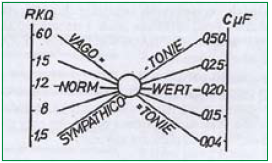
Figure 3: Scale-Bar Principle/Rilling of the Vegetative Regulation Situation (VRL) [10-12]
The values for S-, N- or V- were established with approximately 10,000 Biotonometry measurements and in comparison with the clinical picture (corresponds with Table 2). Nowadays there are roughly only ca. 20% healthy Normotonic people, ca. 20% Vagotonic, ca. 20% Sympathicotonic and ca. 40% so called mixed-type of the VNS reaction situations.
Among the sick persons there are almost no Normotonic people. Today in our consumer information society you will find because of our way of thinking, life style and eating habits, approx. 60% exhausted Vagotonics and 40% stressed Sympathicotonics. As in Figure 3, nine possible combinations of the S- and V- tonus emerge and their tonus portions from the 9 VRL (see Figure 3).
6. Main characteristics of the Biotonometry/Kracmar-Rilling
- The R value (in kΩ) corresponds to the function of the Vagus (parasympathetic) and the C value (in µF) to the function of the sympathetic, the Vegetative Nervous System (VNS).
- Standard values:
Vagotonia: from 60 kΩ
Normotonia: 12 kΩ and 0.2 µF
Sympathicotonia: from 0.5 µF - The vegetative output measurement value (1st VA) is the current vegetative measurement status, which is decisive for therapy. Only the first measurement is considered, further measurements are already changed by the electrical charges of the measurements.
- With partial regulation blockages either C or R values remain practically unchanged in the long term curve. With complete regulation blockages C and R values remain practically unchanged in the vegetative long term curve.
- The vegetative short term curve of the VRL = 9 x measurements in the space of 10 minutes; serves as the test for the effect of a medication (as a medication test), and application for example of the effect from IO2Th/Engler. A placebo effects no change of the R and C values. If the R and C values approach the norm, this indicates a probiotic effect of the therapy. If these values go away from the norm, it means an abiotic, unfavorable effect of the therapy or an overdose. The first measurement, in a sense an overloading of the C and R values, can however allow a deviation far from normotonia.
- The vegetative long term curve of the VRL = recording the R and C values during a longer time period, over the course of days, weeks or months:
It is suited for observation of chronically ill, geriatric and cancer patients, and is definitive for the production of the long term effect of therapy or the prognosis of illness. - Prognosis – constantly rising R values and falling C values mean poor to unfavorable prognosis (poor state of health of the patients, worsening laboratory values and device examinations).
R and C values again approaching normotonia indicate a good prognosis (good state of health of the patient, better laboratory values and device examinations).
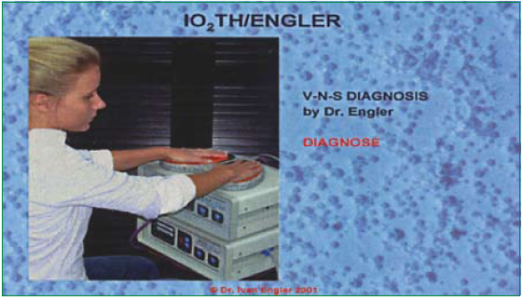
Figure 4. “VNS Diagnosis 3000 / by Dr. Engler” connected with the “Oxygen Ion 3000 / by Dr. Engler” [from 3, Page 92].
7. “VNS Diagnosis 3000 / by Dr. Engler” – An innovative measuring instrument for Biotonometry
- Allows the simultaneous measurement of the C and R values with a new PC electronics technology with gold-plated surface hand electrodes (or thigh electrodes) and diagnoses one of nine possible VRL (see Figure 3 and Table 4).
- The R and C values of the patient are recorded before and after each treatment and are stored on the PC in the form of a short term or long term curve of the VRL and are printed out on demand.
- Connection to the computer and special software make possible the digital processing of the measurement data, its storage or plotting in a short term or long term curve (see under 6.5 and 6.6).
- The electronic coupling to the Oxygen Ionization device, “Oxygen Ion 3000 / by Dr. Engler [1-3] automatically chooses one of the 9 therapy programs for the IO2Th/Engler.
Therefore it automatically chooses the optimal ion polarity (O2-● or O2+●), and respectively its time related combination, so that the patients are optimally treated by any one of the 9 possibilities. - The effect of a therapy and the prognosis of the illness is controlled and stored in the PC program according to need.
- That C and R measurement device holds the EU certificate as a medical diagnostic device.
With the help of two gold-plated surface hand electrodes on which the test person lays his hands, after a minimal skin burdening by a not consciously discernible electrical current impulse, the electrical polarization capacity C (in µF) and the polarization resistance of the skin (in kΩ) is measured.
8. Vegetative Reaction Situations (VRL) of the VNS measured by Biotonometry
The measurements should be carried out once, as much as possible with the test persons rested (minimum 5 minutes), at the same time of day, with the same pressure, previously washed and well dried off hands and sitting. The hands should be grease free! The gold plated surface electrodes should be at room temperature, clean and grease free. The C value fluctuates little, it is more difficult to influence, but it is definitive for the VNS. The C and R values fluctuate in the sense of the day-night rhythms. The R value fluctuates distinctively stronger and is easier to influence.
Summary
There are brief and clear reports on the construction, function and disturbances of the Vegetative Nervous System (VNS) and particularly on the clinical and device possibility of diagnosis of the tonus of the Sympathetic (S-) and Parasympathetic (or the Vagus, V-). There are informative reports on the lesser known role of the Extracellular Regulative Ground System (ERGS) with regard to the VNS.
Besides the “clinical picture”, a special questionnaire or an orthostatic test are discussed as well as device diagnosis methods like HFV, BPV and Biotonometry with regard to the VNS.
The Innovative Biotonometry Measurement Device “VNS Diagnosis 3000 / by Dr. Engler”
(European Union certificate for medical diagnostic devices.) It simultaneously measures the C value of the capacity (in µF) which is attributed to the Sympathicotonus and the R value of the reisistance (in kΩ) which corresponds to the Vagotonus.

The Vegetative Regulation Answer (VRA) of the VNS occurs after a minimum current burdening predominantly of the ERGS on the skin, through the two surface hand electrodes. Thus you can determine nine different VRL and their clinical considerations. The short term VRL curve is for determining a medication test, the choice of O2- or O2+ by inhalation or for control of the effectiveness of the therapy. The long term VRL curve makes a statement about the prognosis of every illness and is particularly proved with geriatric and cancer patients.
 A Confidential Translated Article for Members
A Confidential Translated Article for Members
From THE BRIDGE Newsletter of OIRF
Published September 2008
From an article in OM & Ernährung, 2007/Nr. 120
Machine Translation by SYSTRAN, Lernout & Hauspie, LogoMedia & Promt
Translation & redaction by: Carolyn L. Winsor, OIRF
© Copyright 2007, Prof. Dr. Ivan Engler, Salzburg, Austria
By Dr. med. Univ. Ivan Engler
Salzburg, Austria
Ärzteforschung für Naturheilverfahren, Salzburg
Footnote:
* “The Finometer PRO and the Finometer MIDI are non-invasive stationary blood measurement and beat to beat haemodynamic monitoring systems that incorporate proprietary ModelFlow® methodology for Cardiac Output.”
Translation of the terms from Figure 1:
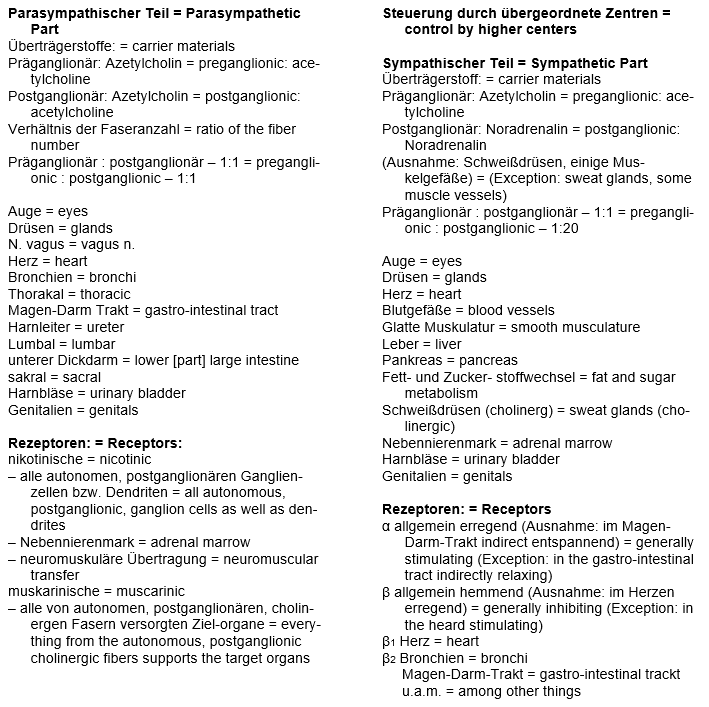
Literature
- Engler;I.: Informationen über Ionisierte Sauerstoff-Therapie IO2Th/Engler, Überblick für Patienten und Ärzte, OM&Ernährung 2007/Nr. 119
- Engler,: Sauerstoff-Therapie? Ja! Aber mit welchem Sauerstoff? OM&Ernährung 2006/Nr.117
- Engler,: Handbuch Ionisierter Sauerstoff-Therapie (IO2Th/Engler) im Spiegel der Ganzheitsmedizin. Prävention und adjuvante Behandlung der chronischen-zivilisatorischen Krankheiten besonders des Alters und des Krebse, Spurbuchverlag, Baunach, 2004, 250 S.
- Engler, : Strategie für ein gesundes, langes Leben, Spurbuchverlag, Baunach, 1999
- Hacker G.W. et al.: Biomedical evidence of influence of geopathic zones on the human body: Scientifically traceable effects and ways of harmonization. Forsch. Kompl. Med. Klass Naturhlkd. (Res. Compl. & Nature Medicine), Karger, 12:315-327 (2005).
- Hauswirth, O.: Vegetative Konstitutionstherapie, Springer Verlag, Wien, 1953, 280 S.
- Litscher, G. et al.: Lasernadel-Akupunktur, Wissenschaft und Praxis, Pabst Science Publishers, Lengerich, 2004
- Opavský, J.: Autonomní nervový system a diabetická autonomní neuropatie. Klinické aspekty a diagnostika. Nakladatelství Galen, Praha, 2002, 220 Str.
- Pischinger, A, Heine, H. et al.: Das System der Grundregulation. Grundlagen für eine ganzheitsbiologische Theorie der Medizin. & überarbeitete Auflage. Haug Verlag. Heidelberg, 1988, 218 S.
- Rilling, S.: Biotonometrie 2002-Medizin ist messbar, herausgegeben vom Autor, Tübingen, 2. Auflage 2002.
- Rilling, S.: Biotonometrie-Grundlagen und Anwendung, Biotonomed Messgeräte, Stuttgart, 1971, 54 S.
- Rilling, S.: Was versteht man unter R-C- Messung? (Ein Bericht über 80.000 Einzelmessungen), Erfahrungsheilkunde, Band XVII, Heft 10, 1968
- Rilling, S.: Vagus und Sympathikus in Diagnostik und Therapie. Aufriss einer elektrodynamischen Medizin. Karl Haug Verlag, Ulm/Donau, 1957, 280 S.
- Seley, H.: The Stress of Life, McGraw-Hill Company, Montreal, 1984
- Silbernagel, S., Despopoulos, A.: Taschenatlas der Physiologie, 4. überarbeitete Auflage. Thieme Verlag, Stuttgart-New York, 1991, 371 S.



